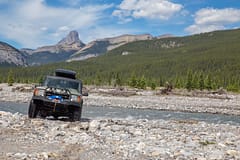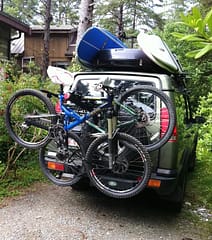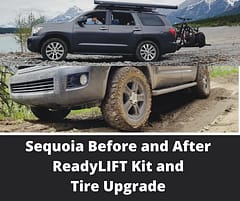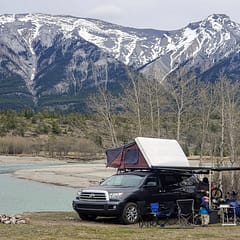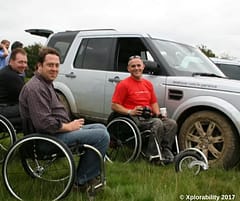How to Drive on Sand Without Getting Stuck
Expert Tips on Driving in Sand
Contents
- Basic Driving in Sand Tips
- Three Common Sense Driving Tips for Beaches
- Recovery From Being Bogged in Sand
- Driving in Sand Summary
Introduction
Do you have the pleasure to live or travel in a sandy location? Tropical beach, rolling sand hills or maybe it’s the desert for work. No matter where your sandy destination is be alert of the challenges of driving in sand. Too many people join the ‘digging club’ and it’s one club you’d rather avoid.
Please note this is general Sand not Desert Driving, although many of the basic principles are the same, Desert Driving is a “long” discussion in itself.

This content, How to Drive on Sand Without Getting Stuck, was developed by and owned by Paul Sinkinson, Xplorability owner. Paul is a 4wd Defensive Driver Training Consultant/Trainer and Programme Developer.
Basic Driving in Sand Tips
- A variety of conditions may co-exist - Learn to recognise surface conditions
- Beware of “wet sand”. These areas can seem bottomless and usually require assistance from other vehicles with a winch to extricate
- If unsure carry out surveying of the area on foot
- Engage high ratio 4wd for long beach runs on hard sand. Engage low ratio 4wd for soft sand and dunes to avoid overheating transmission
- Avoid sharp turns and wheel spin
- Utilise speed for controlled momentum
- Keep gear changes to a minimum – Normally choose a gear and stay in it to avoid baulking
- Low tyre pressures are highly recommended
- If it becomes necessary to stop on soft sand, try to choose an area that allows a down hill restart
- To get re-started on flat, soft, dry sand. Reverse 1-2 metres and form hard sand ramps so as to get a good starting speed before hitting soft sand again
- To ascend a sand hill, utilise controlled momentum. If you fail to ascend, back down the same wheel tracks far enough to allow a faster approach up the same wheel tracks
- To descend keep vertical to the sand hill/descent and avoid brakes, accelerate gently if necessary to aid descent.
There is Nothing Quite Like Driving on Sand
Most off-roaders may never come across sand unless they happen to make it to coastal regions and hit the beach. However, if they do start to undertake longer distance adventure treks, they may at some time make it to the more arid regions and the odd few may even make it to the “Real” Desert. Perhaps like myself, when I first flew in on a light aircraft to a desert strip in the deep Sahara to run driver training, their answer to the question from colleagues as to what they thought of the place will be the same as mine. “I think I’m going to need a bigger bucket and spade!”
Beach Sand
Beach Sand is totally different to the sand you find in the desert. Much of it tends to be much coarser in grain texture and therefore can at time be more forgiving that the desert sand that runs like water. Of course, being close to the sea it can also be damp, wet, extremely wet or waterlogged. It can also be dry, gravelly and have the odd rock thrown in for good measure. Away from the water’s edge you will often find dunes, some with vegetation, some without and in certain areas around the World you will find larger dunes, similar to the ones you find in the desert. While those dunes look similar and do have some of the same features they are very different. We’ll come to that later but only touch on them briefly as “real” desert driving needs lots of space for discussion on techniques.
So, we’ve hit the beach, some great scenery, lots of fresh air, all your mates are with you looking at those long, sometimes wide strips of sand with the waves lapping at the edge. This is usually where common sense and safety goes out of the window! Competitive, idiotic behavior, spurred on usually by male testosterone reacting with the ozone fresh sea breeze leads to frantic and erratic driving at high speed along the sand and often in and out of the water. Beaches are great BUT they are not playgrounds with your truck. In a 4wd Vehicle they can be one of the most dangerous places you will ever drive. The normal Hazard Identifications when off-roading apply, so read the earlier article on this on the site.
Three Common Sense Driving Tips for Beaches
-
Keep out of the Sea: Salt Water is not good for 4wd vehicle chassis and body components. Driving in the Sea as many will do despite this article, will throw salt water everywhere and it will get into the chassis, it will in time cause rust erosion and pressure washing after may nod get rid of it. Vehicle electrics and water do not go well together at any time. Hot radiator fins are thin, if salt water passes through the fins the heat dries it and the salt deposit remains to eat its way into the core. I’ve seen many a vehicle being taken home on a recovery truck from the beach due to water getting into badly position ECU and ignition units in the engine bay. It may look fantastic, cause lots of spray and a splash – BUT KEEP OUT OF THE SALT WATER!
-
Ok, hopefully you’ve got the message on point one and you’re just going to drive on the beach sand. It looks nice and flat; it may even look fairly dry. However, it’s a beach, normally the tide comes in and out twice a day that means, although it may look dry on the surface because of all that “Sunshine” in some Countries, it could well be soggy under the surface. You can drive it in either high or low range but KEEP THE SPEED DOWN.
-
As mentioned, it can be soggy below the surface or it can also be dry with patches of deeper sand. Keep driving in straight lines on it and NEVER turn sharply as if a front wheel happens to dig in the softer areas it will immediately act as a brake, weight will transfer on to it and you’ll become a statistic in the rollover records. These beach rollovers happen every day around the globe. IF you are going to turn, firstly slow down and secondly turn in a wide arc. It doesn’t take much for a loaded 4wd, especially if you have equipment high up on a roof rack, for the dynamics to transfer weight. Even experienced and regular beach drivers forget this simple message. I’ve been on beaches around the world and viewed many who thought they were “experts,” being scraped up by the medics or recovery vehicles. Don’t join their gang!
NOTE: In an effort to try and keep you SAFE watch some videos. There are plenty of good and instructional videos covering Sand on the Internet - (YouTube etc.) A good one is “Guide to Off-Roading – Driving on Sand – by Land Rover Experience.
There are also lots of videos that highlight the art of BAD Driving on both Beach and Desert Sand. They cover the accidents! Watch those ones several times and then look around you at the kids and the rest of your family and consider the implications should you drive in Sand (or anywhere else for that matter) like some of the idiots involved in these incidents.
Keep everyone’s Seat Belts on – Don’t let the kids hang out of the Sunroof or Side Windows. If you see some of the more serious rollover accidents you will understand why.
Driving on Sand
It is reasonable to assume that you can drive on firm sand if you take notice of the previous three tips but there will come a time when the surface will not be firm and supple sand is a different thing altogether. Once you start driving in the softer sand, traction can be at a premium, any increase in speed may be and usually is, difficult if not impossible, so to make headway you need to maintain momentum. Should you lose that, it is unlikely you will regain it and you will likely become bogged down.
Once you lose traction in sand and have wheel-spin, abort immediately or you will just dig yourself in further. Engage reverse gear and “Gently” try to drive out along your tracks.

Tyre Pressures
Assuming you are going to be on the beach or coastal sand for any length of time rather than just sticking your nose in for a few minutes to take in the sea air, it is advisable to reduce your tyre pressures. The reason for this is that it provides what is termed as a better footprint reducing the ground pressure and allowing better “flotation” which in turn improves traction. (Think of the “Snow Shoe” effect on Snow).
Most people think that reducing the tyre pressure makes the contact with the ground wider because they see the tyre “bulge” out and become fatter. In reality, this is not the case, the tyre footprint actually becomes longer although there may be a slight increase in width. If you have ever seen a vehicle with a punctured tyre you will remember it was flat at the bottom along the ground for maybe 18 to 20 inches whereas when it was inflated, only 8 inches were in contact with the ground. When it comes to low ground pressure, “Size Matters.” With lower ground pressure there is less strain on the vehicles steering components as well as the power unit and transmission as they don’t have to work as hard.
Before you consider lowering the pressures you must of course ensure that you have a suitable pump to re-inflate them when you come back to the normal roads and tracks. Assuming you have the pump you can now reduce the pressure but to what level? Often you have the pump but no pressure gauge. Oops! I forgot to pack it in the truck. Now what do I do?
For general sand driving a tyre pressure of circa 15 to 16 psi is the norm. If you don’t have a gauge, you can use the old explorer’s trick of using a stick or a small rock placed an inch away from the edge of the tyre sidewall. On the average 4wd tyre of say 235x85x16, if you now let the air out of the tyre valve until the sidewall touches the stick on each tyre, you should have all the tyres down to the same level and roughly with a suitable amount of deflation. You can use the same method the other way around when you re-inflate so you have them back to the same level for normal use until you can check and adjust with a gauge.
You must remember, now that you have the lower pressure and perhaps with the bulging side-walls, that the tyres are more susceptible to wear or damage. You need to balance the risk when lowering the pressure between the increased traction it delivers and the possible tyre damage and wear. The correct balance will certainly make the difference between being bogged in the sand and driving a way through it. If you are severely bogged in into the sand, you can of course reduce the pressures further to circa 10 psi but certainly not below 6 psi as otherwise the tyre may unseat itself from the wheel rim resulting in it rolling off completely and being damaged. Speed must be kept to a minimum when tyre pressures are low or you could lose directional control. It is essential that you are aware that these recommendations are only for sand driving and they should be increased for driving on stone, rock or hard surfaces.
Now What to Do Behind The Wheel While Driving on Sand
When driving in sand, you should usually try to follow in the tyre tracks of the vehicle in front of you as they have already compressed the sand to form a firmer surface than “virgin” ground. You will gain in experience as you go on and there may be times where too many vehicles have disturbed the sand surface that you will need to consider taking a slightly different route to avoid these to save getting bogged in. Never drive on natural or planted vegetation as this may destroy it, which will lead to environmental damage and erosion. Setting off should be undertaken as smoothly as possible, making gear changes at higher revs than normal. Driving in sand requires plenty of power from your engine to get your vehicle “moving”; on the sand but not so much that you have wheel-spin or you will just dig the wheels in. Always try and drive forwards initially in a straight line in sand, if you want to understand why, just try driving forward in it at tick-over and then turn the steering wheel to half lock. The moment you do, you will feel the vehicle start to slow down with the resistance of the sand as well as the change in engine note as more load comes onto the system.
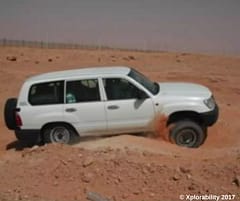
You will read in various magazines that it’s always best to be in low range when driving and as it multiplies the amount of engine torque at your disposal especially I patches of soft sand. However, while there are times you will need to use low range, often it is better to drive in high range over most sand areas and when you see the surface deteriorate that’s the time to consider the advantages of the low transfer gears.
I mention “Gears” here – the reason I suggest the “High Range” is that your transmission, Axles, Gearbox and Transfer case rely on the oil in them to lubricate the moving parts. This oil is either cooled by the vehicle’s oil coolers or through air passing over the various components. In Low Range, you will be moving much more slowly (although not a bad thing) and therefore as such, these items may not be being cooled sufficiently, especially if you happen to be in warm or hot climates as the reflected heat from the sand surface combined with the normal air temperatures can be much higher. Obviously, you will gain in experience and judgment the more you operate in these conditions and choose your gearing accordingly. As you drive along in sand, try and avoid dramatic or excessive changes of speed or braking. If you accelerate too quickly you are likely to dig the wheels in, similarly with heavy braking as that just pushes a sand wall in front of the tyres, which makes setting of again much harder.
If you have to stop when on sand, it’s always best to depress the clutch on a manual and just let the vehicle coast to a standstill as this way there is no build up of sand in front of the tyres so it makes for an easier start afterwards. On the automatic, you can just slip into neutral for the same effect. If the terrain permits, always try and come to a halt on a slight downgrade rather than uphill as that too makes for an easier restart. You will find it is best not to stop in the middle of gullies or at the base of dunes as they usually are areas of soft sand. Before you set off, it’s always a good idea to reverse a couple of yards on the pre-compressed sand so that you have a good start when you set off forward again.
When you need to stop, DON’T BRAKE – In a Manual, depress the clutch and coast to a halt to avoid a build up of sand in front of the tyres as this makes for a harder restart. Always try and halt on a slight downgrade rather than uphill for the same reason. (For Automatics, just back off the power and you will roll to a halt just the same way)
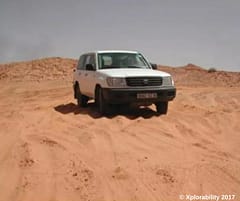
Turning in Sand
As mentioned earlier, turning sharply in sand puts strain on the systems and the drag from the tyres causes a braking effect so ALWAYS make sure you turn with a wider arc than normal to avoid this and do this at a reduced speed as if you turn at speed, the centrifugal forces cause a weight transfer to the outside wheels and they will dig in, this causes extra sideways braking forces and you could finish up with a rollover.
Always make wide arcs when turning as turning tightly the sand acts like a brake and will bog you down.
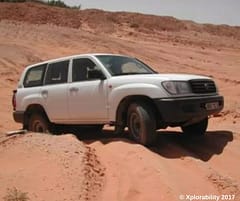
Beach Dunes
I mentioned “Dunes,” generally the dunes near beaches are not too high and, those near the beach front often have vegetation on them which has been planted in an attempt to reduce erosion. KEEP OFF them; they’re like that for a reason. Some beaches do have massive dunes nearby that are not unlike desert dunes, in fact my early introduction to driving dunes was many years ago in New Zealand of all places, where the dunes surrounding Pouto Point on Kiapara Harbour were something I never expected to see. At that time, a number were recognized as sites used by 4wd and quad bike enthusiasts but I believe these may now have been closed due to over use.
If you do have legal access to “sustainable” dunes, or if you are ever fortunate to adventure in the desert regions, remember, they are NOT play-pens. They do NOT take prisoners and if you drive them in an idiotic manner they will damage both you and your vehicle. By their very nature, ascending dunes requires momentum due to the braking effect of the sand surface. Momentum initially requires speed. Speed may kill you. Remember the back to basics phrase “As slow as possible, as fast as necessary,” it may keep you safe.
On Beach or Desert Dunes, the sand just before the crest is usually very supple and so it is necessary to have sufficient momentum to pass through this (but not enough to become airborne). You must always be aware of what is over the other side so best to walk and check it out if you are uncertain.
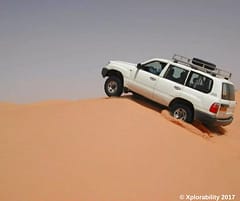
Steep sand dunes should only ever be driven either straight up or straight down. If you drive on them at even a slight angle, the weight transfer is to the downhill side wheels. If the vehicle starts to slip in the loose sand, the downhill wheels tend to dig in and the angle of the dune becomes even worse, this is likely to lead to a potential rollover.
Normally Off-Road, you use Low Range first gear for descents but on sand this can create too much of a braking effect especially in deep supple sand, where your front tyres may dig in. So, perhaps second gear (or even third gear in some circumstances) will be better as you need a steady and continuous descent. If you are descending straight down a steep dune, the weight will be on the front wheels with the rear becoming lighter. If the front ones dig in, be aware that the rear ones may start to slip sideways. If this happens, the recovery sequence is to accelerate slightly to try and straighten the vehicle.
Never use the brakes, as this will cause further weight transfer to the front wheels, which can increase the back end movement. Once you have recovered the situation continue to the dune base but avoid acceleration off it at that point, as you are likely to be entering soft sand. If the front wheels dig in, followed then by the front bar, the vehicle may roll over base over apex.
Just like the areas before the crest of a dune, the sand at the base is also likely to be very supple and soft. Beware that your wheels don’t dig in
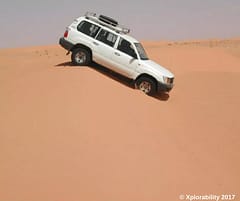
If you are ascending a dune and you fail the climb, reverse down the dune in gear, NEVER coast down the dune and NEVER attempt a U turn. The same ascent and descent rules apply on dunes as to all other terrain so as soon as you finish this article have a re-read of the earlier one on the guide to Ascents and Descents.
Recovery From Being Bogged in Sand
Beyond a shadow of a doubt, if you drive in, on or through sand whether on a beach or in a desert, there will come a time or perhaps many times when you finish up bellied out and stuck in the stuff.
Digging a bogged vehicle from sand is hard and tiring work. Make sure you drink plenty of water. It is a good idea to wear gloves to avoid blisters from the shovel and also, remove your Watch and any Rings as often with sweaty hands and arms they can come off and get lost in the sand.

I will mention the usual types of recovery from sand briefly as hopefully we will prepare a more specific recovery article at a later time. Meanwhile work on the basic themes as follows:
-
If it went in forwards, and you are not fully bogged in, it may well come out fairly easily if you reverse. Don’t just try and plough on forwards or you will just sink deeper. Reverse “gently” over your tracks, as they should be compacted. You may have to remove any sand built up behind all four wheels first so you have a smooth restart in reverse.
-
IF you have an accompanying vehicle, again, it may be better to be recovered backwards BUT ensure the other vehicle turns around so it is driving forwards away from you as it tows you out as if it is in reverse gear (which is its lowest) it too may become bogged in. Remember to clear around your wheels before the tow out and avoid a big snatch pull. A “gentle” tug should get you started and allow the tow vehicle to proceed without bogging down. Once you start moving keep going but don’t crash into your towing vehicle.
-
If you are well bogged down, you may well have to start and do a lot of digging out. This is hard work; make sure you drink plenty of water, as you WILL dehydrate. In extreme cases, you could consider reducing your tyre pressures down to circa 6 psi but remember once recovered, re-inflate them or they could roll off the rims.
-
If you were prepared for driving on sand, you may have sand ladders (aka recovery boards) but for best results you need to get them well under the wheels regardless of the direction you intend to recover. There are a number of ways of doing this without the need for too much digging. First is if you have a suitable “Air Bag Lift.” Second is if you have a suitable accessory bridal and hook strop that fits a high lift jack. There are techniques for using these bits of kit, which we will add in a later recovery article.
-
Winching: BUT, what are you going to winch off? Again, there are specific techniques for this where applicable, to be added in a future recovery article.
-
Snatch Strap/Rope Recovery – Possibly the most dangerous but we will discuss that in a later article. The same rules for extraction/recovery apply to sand as they do to most other “Bog-ins,” the equipment is basically the same. The same SAFETY RULES apply, as does the approach, “DO IT ONCE, DO IT RIGHT!”
Here the guys are working on the principle that if it went in forwards it is better to extract backwards. They are clearing the wheels. As mentioned earlier, it is best to wear gloves to protect your hands from blisters. They didn’t and found out the hard way. This is deep in the Sahara Desert – 55C – The sand runs like water.
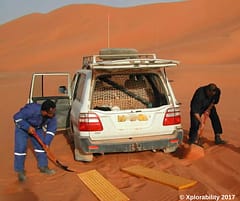
Driving in Sand Summary
- Lowering tyre pressures can generally improve traction and reduce track erosion – Make sure you re-inflate them to correct pressures for road work for the trip home.
- Always drive sensibly using smooth gear changes with higher than normal engine revs
- Make sure the front wheels are pointing straight ahead when starting off
- Remember, soft sand congregates at the base of gullies and dunes
- Always make wide turns to avoid bogging
- NEVER Traverse across the face of a dune, ONLY travel straight up or straight down
- Usually, (although not always) it is best to follow in the tyre tracks of other vehicles and to drive on compressed ground
- Coast to a stop rather than using the brakes to prepare for easier start offs
- Excessive flooring of the accelerator when you are “bogging” down will only make the situation worse
- If you find you are starting to get bogged, try to reverse out along your own tracks
- After ANY Beach or Sand trip make sure your thoroughly “Jet Wash” your vehicle to get rid of any Salt/Sand deposits.
Remember those Geometric Limits mentioned in a previous article in the Training Pages!
Make sure you have sufficient momentum to drive over the crests otherwise you get to join the “Digging” Club.
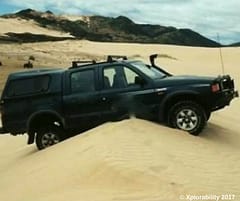
Previous Article: Off-Road Rollovers
Next Article: Guidelines to Driving on Snow and Ice
Copyright
This content was prepared for the Off-Road Discovery Website by Xplorability 4wd Training
The Content - All Photographs and Photographic Copyright and All other Rights other Reserved October 2017. S.W. France This content may not be copied or reproduced without the written consent of Paul Sinkinson – Xplorability Training.
For Use Only in 4wd and Light Vehicle Driver Training.
Not for Re-Publication, Distribution or use outside the Xplorability Training Programme
